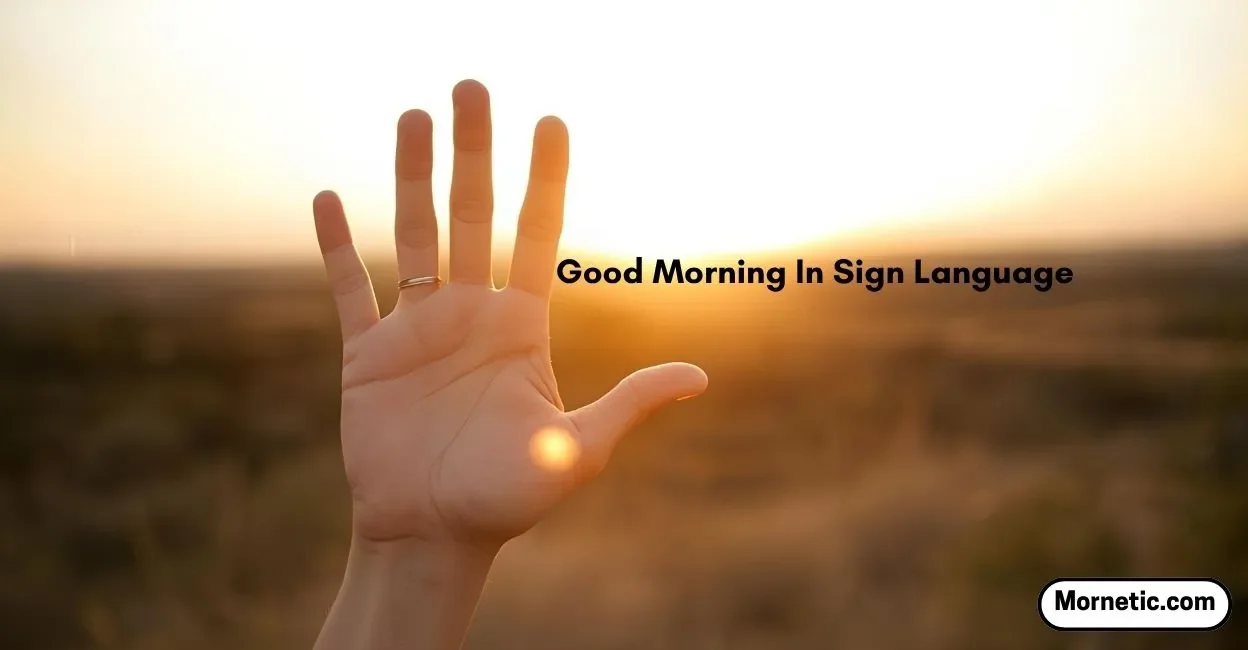Starting your day with a warm “Good Morning” is one of the simplest ways to spread positivity — and when you do it in sign language, it becomes even more meaningful. Whether you’re learning British Sign Language (BSL) or American Sign Language (ASL), this guide will help you master how to say good morning in sign language step by step.
By the end of this article, you’ll know exactly how to perform the sign, understand its variations across regions, and learn a few practical tips to make your communication with the deaf or hard of hearing community more natural and confident. 👋
Good Morning in Sign Language
Learning to say good morning in sign language involves two simple parts — the sign for “good” and the sign for “morning.”
Here’s how each part works:
- ✋ “Good” – Place your dominant hand with fingers flat on your chin (like you’re gently touching it). Then, move your hand forward and down toward your non-dominant hand, which stays flat in front of your chest.
- 🌅 “Morning” – Place your non-dominant arm horizontally across your body like a base. Then, use your dominant hand (palm facing upward) and raise it from below the arm to above — like the sun rising over the horizon.
Combine the two signs: first sign “good,” then “morning.” And there you have it — your cheerful good morning in sign language! 🙌
🧠 Quick Tip:
If you’re new to sign language for beginners, it’s helpful to practice in front of a mirror to check your gesture clarity and body posture.
Step-by-Step Guide to Saying “Good Morning” in Sign Language
Let’s break it down into a step-by-step signing guide you can follow easily:
- Start relaxed — Stand or sit comfortably with your hands visible.
- Sign “Good”:
- Touch your chin lightly with the flat fingers of your dominant hand.
- Move the hand downward to meet your other hand, palm up.
- Sign “Morning”:
- Keep your non-dominant arm horizontal.
- Lift your dominant hand from beneath that arm, like the sun rising.
- Combine them:
- Perform both signs smoothly, keeping a friendly facial expression.
- Repeat with rhythm:
- Practice a few times to make your movement flow naturally.
- Watch tutorials:
- Follow a signing tutorial or sign language video online to ensure accuracy.
- Practice with a friend:
- Try greeting someone in sign language every morning.
- Focus on expression:
- In sign language, facial expression matters just as much as hand movement.
- Learn both versions:
- Try the ASL hand movements and the BSL two-handed sign language version to compare.
- Stay consistent:
- Develop a consistent practice regimen for best results.
How to Say Good Morning in ASL (American Sign Language)
If you’re learning American Sign Language, here’s how to sign “good morning” specifically in ASL:
- Good: Place the flat fingers of your right hand (dominant hand) at your lips, then move it down to your left hand (non-dominant hand), which is flat and facing up.
- Morning: Keep your left arm bent across your body; raise your right arm under it like the sun coming up.
👐 Tip: Keep your movements smooth and gentle — in ASL, fluid motion is key for natural communication.
🎥 Video tutorial suggestion: Search “how to sign good morning in ASL” on YouTube — you’ll find several clear visual learning videos made by ASL tutors and interpreters.
How to Say Good Morning in BSL (British Sign Language)
In British Sign Language, the structure and movements differ slightly from ASL.
Here’s the BSL version step-by-step:
- Good: Use your dominant hand (usually the right hand) and move it forward from your chin with a slight nod.
- Morning: Move your dominant hand upward in an arc, symbolizing the rising sun.
- Combine both: sign “good” first, then “morning.”
👉 Note: BSL sign supported English (SSE) might use similar hand movements, but the order and grammar can differ slightly.
💡 Pro Tip: If you’re unsure, follow a BSL tutor or check the British Sign Language online learning platform for verified examples.
Tips for Learning and Teaching “Good Morning” in Sign Language
Learning sign language can be an amazing journey. Here are some practical tips to make it easier and more enjoyable:
- 📚 Start small: Focus on basic sign language phrases like greetings before moving to complex sentences.
- 🧑🏫 Use a tutor or online course: Platforms for learning BSL/ASL online can speed up your progress.
- 🎬 Visual learning helps: Watch sign language videos regularly to memorize movements.
- 🤝 Practice daily: Incorporate signing into your morning routine.
- 🪞 Use a mirror: It helps you monitor hand positions and gesture clarity.
- 😄 Smile and express: Facial expression enhances visual communication and makes your sign genuine.
- 👋 Engage with the deaf community: Practice real conversations to build confidence.
- 📲 Join online groups: There are many sign language learning communities on social media.
- 💬 Repeat phrases: Say “good morning” to your family or friends in sign every day.
- 🔁 Review regularly: Repetition helps your memory stick — that’s the secret to fluency!
Make It Stick! (Daily Practice Tips)
Want your new skill to last? Here’s how to make “good morning in sign language” part of your life:
- Create a routine: Start every morning by signing “good morning” to yourself in the mirror.
- Record your progress: Take short videos of your signing to track improvement.
- Mix with emojis: Combine 👋🌞 emojis with your sign language greetings in messages for fun, inclusive communication.
- Teach others: Share your skill — it helps you retain what you learn.
- Set a daily reminder: A little nudge goes a long way in building habits.
- Join workshops: Attend local sign language education events or webinars.
- Focus on posture: Correct body posture in signing makes your signs clearer.
- Learn from feedback: Ask a sign language interpreter or friend for tips.
- Keep learning new signs: Expand your knowledge with more morning greetings or daily expressions.
- Celebrate milestones: Every new sign you master is progress — give yourself credit! 🎉
Why Learning “Good Morning” in Sign Language Matters
Saying “good morning” in sign language isn’t just a gesture — it’s a way to promote inclusive communication and connect with the deaf or hard of hearing community with empathy and respect.
By learning simple greetings, you’re opening a door to better understanding and more meaningful interactions. Whether you use ASL, BSL, or any other sign system, your effort to communicate visually sends a powerful message of kindness and inclusion. 💖
Conclusion
Learning how to say good morning in sign language is a small yet powerful step toward becoming more inclusive and expressive.
You now know the difference between ASL and BSL, how to perform the step-by-step signs, and how to build a consistent practice regimen that keeps your skills sharp.

Grace is a lifestyle writer from California who loves starting mornings with positivity. At Mornetic, she shares uplifting quotes and cheerful messages to brighten your day.




